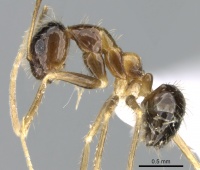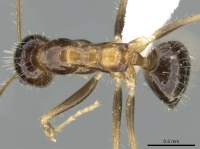Paratrechina antsingy
| Paratrechina antsingy | |
|---|---|

| |
| Scientific classification | |
| Kingdom: | Animalia |
| Phylum: | Arthropoda |
| Class: | Insecta |
| Order: | Hymenoptera |
| Family: | Formicidae |
| Subfamily: | Formicinae |
| Tribe: | Lasiini |
| Genus: | Paratrechina |
| Species: | P. antsingy |
| Binomial name | |
| Paratrechina antsingy LaPolla & Fisher, 2014 | |
This species is restricted to Madagascar were it is found in dry forest habitats.
Identification
Cuticle smooth and very shiny; brown with patches of lighter cuticle across body, giving species a mottled appearance; SI less than 195.
Keys including this Species
Distribution
Distribution based on Regional Taxon Lists
Malagasy Region: Madagascar (type locality).
Distribution based on AntMaps
Distribution based on AntWeb specimens
Check data from AntWeb
Countries Occupied
| Number of countries occupied by this species based on AntWiki Regional Taxon Lists. In general, fewer countries occupied indicates a narrower range, while more countries indicates a more widespread species. |

|
Estimated Abundance
| Relative abundance based on number of AntMaps records per species (this species within the purple bar). Fewer records (to the left) indicates a less abundant/encountered species while more records (to the right) indicates more abundant/encountered species. |

|
Biology
Castes
Images from AntWeb
 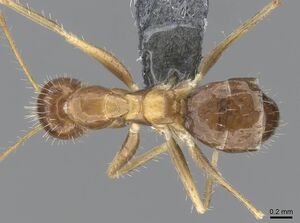 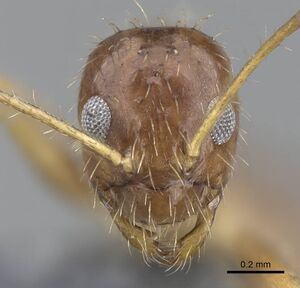 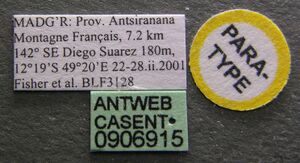
| |
| Paratype of Paratrechina antsingy. Worker. Specimen code casent0906915. Photographer Michele Esposito, uploaded by California Academy of Sciences. | Owned by CAS, San Francisco, CA, USA. |
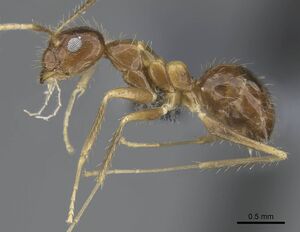 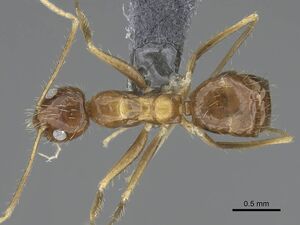 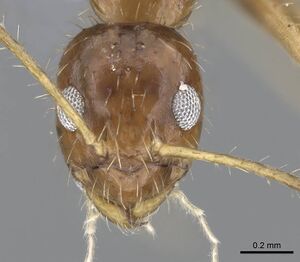  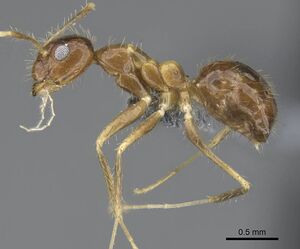
| |
| Holotype of Paratrechina antsingy. Worker. Specimen code casent0906916. Photographer Michele Esposito, uploaded by California Academy of Sciences. | Owned by CAS, San Francisco, CA, USA. |
Nomenclature
The following information is derived from Barry Bolton's Online Catalogue of the Ants of the World.
- antsingy. Paratrechina antsingy LaPolla & Fisher, 2014: 43, figs 4-6 (w.) MADAGASCAR.
Holotype worker. MADAGASCAR: Province Antsiranna, Montagne Français, 7.2 km 142° SE Diego Suarezi, 180m, 12°19'S, 49°20'E, 22–28.ii.2001, Fisher et al. CASENT0906916 (CASC).
Paratypes. 12 paratype workers with same locality information as holotype (BMNH, CASC, USNM). Worker diagnosis. Cuticle smooth and very shiny; brown with patches of lighter cuticle across body, giving species a mottled appearance; SI less than 195.
Description
Worker. Measurements (n=6) TL: 2.07–2.69; HW: 0.58–0.60; HL: 0.67–0.70; EL: 0.17–0.19; SL: 1.02–1.08; PW: 0.40–0.44; WL: 0.97–1.02; GL: 0.76–1.05; PFL: 0.74–0.78 CI: 84–89; REL: 26–28; REL2: 29–32; SI: 177–180; SMC: 24–30; PMC: 4–5; MMC: 3–4.
Brown with lighter areas on mandibles, antennae, lateral portions of head, mesonotum, pronotum, mesonotum, trochanters and joints of femora; first gastral tergite with mottled lighter and darker areas; cuticle smooth and very shiny, except for mesonotum, metanotal area and propodeum being slightly rugolose; scapes, head, pronotum, mesonotum and gaster with abundant macrosetae; scapes with short, appressed pubescence. Head ovate; posterolateral corners rounded with complete posterior margin; midpoint of eyes at approximately midline of head; eyes convex; 3 small ocelli present; mandibles with 5 teeth; apical tooth the longest, 3rd tooth from apical shortest, remainder about the same size; outer mandibular surface with slight striations across surface. In lateral view, pronotum convex; pronotal/mesonotal margin with mesonotum raised slightly above margin; propodeum convex with dorsal face rising steeply to a rounded peak with steep declivitous face; metanotal suture with distinct impression that extends down along the mesopleural/metapleural margin.
Etymology
The specific epithet is derived from the name of the province where the species was found.
